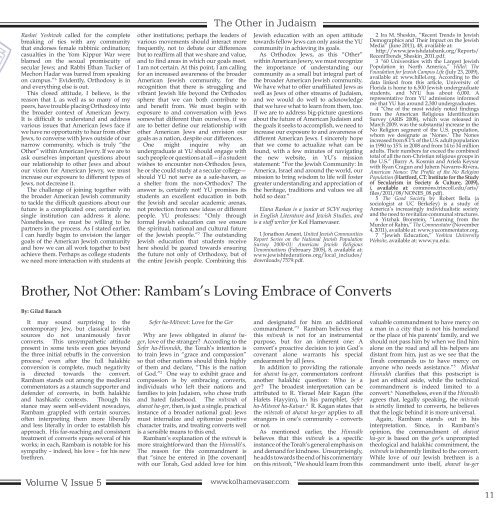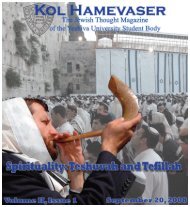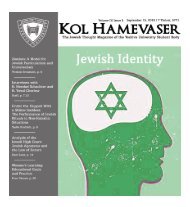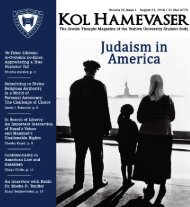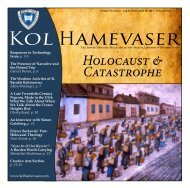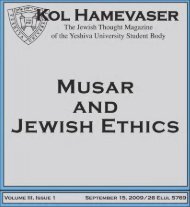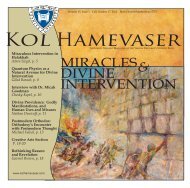The Other in Judaism - Kol Hamevaser
The Other in Judaism - Kol Hamevaser
The Other in Judaism - Kol Hamevaser
You also want an ePaper? Increase the reach of your titles
YUMPU automatically turns print PDFs into web optimized ePapers that Google loves.
Rashei Yeshivah called for the complete<br />
break<strong>in</strong>g of ties with any community<br />
that endorses female rabb<strong>in</strong>ic ord<strong>in</strong>ation;<br />
casualties <strong>in</strong> the Yom Kippur War were<br />
blamed on the sexual promiscuity of<br />
secular Jews; and Rabbi Ethan Tucker of<br />
Mechon Hadar was barred from speak<strong>in</strong>g<br />
on campus.” 6 Evidently, Orthodoxy is <strong>in</strong><br />
and everyth<strong>in</strong>g else is out.<br />
This closed attitude, I believe, is the<br />
reason that I, as well as so many of my<br />
peers, have trouble plac<strong>in</strong>g Orthodoxy <strong>in</strong>to<br />
the broader context of American Jewry.<br />
It is difficult to understand and address<br />
various issues that American Jews face if<br />
we have no opportunity to hear from other<br />
Jews, to converse with Jews outside of our<br />
narrow community, which is truly “the<br />
<strong>Other</strong>” with<strong>in</strong> American Jewry. If we are to<br />
ask ourselves important questions about<br />
our relationship to other Jews and about<br />
our vision for American Jewry, we must<br />
<strong>in</strong>crease our exposure to different types of<br />
Jews, not decrease it.<br />
<strong>The</strong> challenge of jo<strong>in</strong><strong>in</strong>g together with<br />
the broader American Jewish community<br />
to tackle the difficult questions about our<br />
future is a complicated one; certa<strong>in</strong>ly no<br />
s<strong>in</strong>gle <strong>in</strong>stitution can address it alone.<br />
Nonetheless, we must be will<strong>in</strong>g to be<br />
partners <strong>in</strong> the process. As I stated earlier,<br />
I can hardly beg<strong>in</strong> to envision the larger<br />
goals of the American Jewish community<br />
and how we can all work together to best<br />
achieve them. Perhaps as college students<br />
we need more <strong>in</strong>teraction with students at<br />
other <strong>in</strong>stitutions; perhaps the leaders of<br />
various movements should <strong>in</strong>teract more<br />
frequently, not to debate our differences<br />
but to reaffirm all that we share and value,<br />
and to f<strong>in</strong>d areas <strong>in</strong> which our goals meet.<br />
I am not certa<strong>in</strong>. At this po<strong>in</strong>t, I am call<strong>in</strong>g<br />
for an <strong>in</strong>creased awareness of the broader<br />
American Jewish community, for the<br />
recognition that there is struggl<strong>in</strong>g and<br />
vibrant Jewish life beyond the Orthodox<br />
sphere that we can both contribute to<br />
and benefit from. We must beg<strong>in</strong> with<br />
exposure to and conversation with Jews<br />
somewhat different than ourselves, if we<br />
are to better def<strong>in</strong>e our relationship with<br />
other American Jews and envision our<br />
goals as a nation, despite our differences.<br />
One might <strong>in</strong>quire why an<br />
undergraduate at YU should engage with<br />
such people or questions at all—if a student<br />
wishes to encounter non-Orthodox Jews,<br />
he or she could study at a secular college—<br />
should YU not serve as a safe-haven, as<br />
a shelter from the non-Orthodox <strong>The</strong><br />
answer is, certa<strong>in</strong>ly not! YU promises its<br />
students an excellent education <strong>in</strong> both<br />
the Jewish and secular academic arenas,<br />
not protection from new ideas or different<br />
people. YU professes: “Only through<br />
formal Jewish education can we ensure<br />
the spiritual, national and cultural future<br />
of the Jewish people.” 7 <strong>The</strong> outstand<strong>in</strong>g<br />
Jewish education that students receive<br />
here should be geared towards ensur<strong>in</strong>g<br />
the future not only of Orthodoxy, but of<br />
the entire Jewish people. Comb<strong>in</strong><strong>in</strong>g this<br />
<strong>The</strong> <strong>Other</strong> <strong>in</strong> <strong>Judaism</strong><br />
Jewish education with an open attitude<br />
towards fellow Jews can only assist the YU<br />
community <strong>in</strong> achiev<strong>in</strong>g its goals.<br />
As Orthodox Jews, as this “<strong>Other</strong>”<br />
with<strong>in</strong> American Jewry, we must recognize<br />
the importance of understand<strong>in</strong>g our<br />
community as a small but <strong>in</strong>tegral part of<br />
the broader American Jewish community.<br />
We have what to offer unaffiliated Jews as<br />
well as Jews of other streams of <strong>Judaism</strong>,<br />
and we would do well to acknowledge<br />
that we have what to learn from them, too.<br />
If we are to address big-picture questions<br />
about the future of American <strong>Judaism</strong> and<br />
the goals it seeks to accomplish, we need to<br />
<strong>in</strong>crease our exposure to and awareness of<br />
different American Jews. I s<strong>in</strong>cerely hope<br />
that we come to actualize what can be<br />
found, with a few m<strong>in</strong>utes of navigat<strong>in</strong>g<br />
the new website, <strong>in</strong> YU’s mission<br />
statement: “For the Jewish Community: In<br />
America, Israel and around the world, our<br />
mission to br<strong>in</strong>g wisdom to life will foster<br />
greater understand<strong>in</strong>g and appreciation of<br />
the heritage, traditions and values we all<br />
hold so dear.”<br />
Elana Raskas is a junior at SCW major<strong>in</strong>g<br />
<strong>in</strong> English Literature and Jewish Studies, and<br />
is a staff writer for <strong>Kol</strong> <strong>Hamevaser</strong>.<br />
1 Jonathon Ament, United Jewish Communities<br />
Report Series on the National Jewish Population<br />
Survey 2000-01: American Jewish Religious<br />
Denom<strong>in</strong>ations (February 2005), 8, available at:<br />
www.jewishfederations.org/local_<strong>in</strong>cludes/<br />
downloads/7579.pdf.<br />
2 Ira M. Shesk<strong>in</strong>, “Recent Trends <strong>in</strong> Jewish<br />
Demographics and <strong>The</strong>ir Impact on the Jewish<br />
Media” (June 2011), 48, available at:<br />
http://www.jewishdatabank.org/Reports/<br />
RecentTrends_Shesk<strong>in</strong>_2011.pdf.<br />
3 “60 Universities with the Largest Jewish<br />
Population <strong>in</strong> North America,” Hillel: <strong>The</strong><br />
Foundation for Jewish Campus Life (July 23, 2009),<br />
available at: www.hillel.org. Accord<strong>in</strong>g to the<br />
data l<strong>in</strong>ked from this article, University of<br />
Florida is home to 6,500 Jewish undergraduate<br />
students, and NYU has about 6,000. A<br />
representative from YU admissions <strong>in</strong>formed<br />
me that YU has around 2,300 undergraduates.<br />
4 “One of the most widely noted f<strong>in</strong>d<strong>in</strong>gs<br />
from the American Religious Identification<br />
Survey (ARIS 2008), which was released <strong>in</strong><br />
March 2009, was the substantial <strong>in</strong>crease <strong>in</strong> the<br />
No Religion segment of the U.S. population,<br />
whom we designate as ‘Nones.’ <strong>The</strong> Nones<br />
<strong>in</strong>creased from 8.1% of the U.S. adult population<br />
<strong>in</strong> 1990 to 15% <strong>in</strong> 2008 and from 14 to 34 million<br />
adults. <strong>The</strong>ir numbers far exceed the comb<strong>in</strong>ed<br />
total of all the non-Christian religious groups <strong>in</strong><br />
the U.S.” (Barry A. Kosm<strong>in</strong> and Ariela Keysar<br />
with Ryan Cragun and Juhem Navarro-Rivera,<br />
American Nones: <strong>The</strong> Profile of the No Religion<br />
Population (Hartford, CT: Institute for the Study<br />
of Secularism <strong>in</strong> Society & Culture, 2009),<br />
i, available at: commons.tr<strong>in</strong>coll.edu/aris/<br />
files/2011/08/NONES_08.pdf).<br />
5 <strong>The</strong> Good Society by Robert Bella (a<br />
sociologist at UC Berkeley) is a study of<br />
America’s <strong>in</strong>creas<strong>in</strong>gly <strong>in</strong>dividualistic society<br />
and the need to revitalize communal structures.<br />
6 Yitzhak Bronste<strong>in</strong>, “Learn<strong>in</strong>g from the<br />
Murder of Rab<strong>in</strong>,” <strong>The</strong> Commentator (November<br />
4, 2011), available at: www.yucommentator.org.<br />
7 “Jewish Education,” Yeshiva University<br />
Website, available at: www.yu.edu.<br />
Brother, Not <strong>Other</strong>: Rambam’s Lov<strong>in</strong>g Embrace of Converts<br />
By: Gilad Barach<br />
It may sound surpris<strong>in</strong>g to the<br />
contemporary Jew, but classical Jewish<br />
sources do not unanimously favor<br />
converts. This unsympathetic attitude<br />
present <strong>in</strong> some texts even goes beyond<br />
the three <strong>in</strong>itial rebuffs <strong>in</strong> the conversion<br />
process; 1 even after the full halakhic<br />
conversion is complete, much negativity<br />
is directed towards the convert.<br />
Rambam stands out among the medieval<br />
commentators as a staunch supporter and<br />
defender of converts, <strong>in</strong> both halakhic<br />
and hashkafic contexts. Though his<br />
stance may seem self-evident nowadays,<br />
Rambam grappled with certa<strong>in</strong> sources,<br />
often <strong>in</strong>terpret<strong>in</strong>g them more liberally<br />
and less literally <strong>in</strong> order to establish his<br />
approach. His far-reach<strong>in</strong>g and consistent<br />
treatment of converts spans several of his<br />
works; <strong>in</strong> each, Rambam is notable for his<br />
sympathy – <strong>in</strong>deed, his love – for his new<br />
brethren.<br />
Sefer ha-Mitsvot: Love for the Ger<br />
Why are Jews obligated <strong>in</strong> ahavat hager,<br />
love of the stranger Accord<strong>in</strong>g to the<br />
Sefer ha-H<strong>in</strong>nukh, the Torah’s <strong>in</strong>tention is<br />
to tra<strong>in</strong> Jews <strong>in</strong> “grace and compassion”<br />
so that other nations should th<strong>in</strong>k highly<br />
of them and declare, “This is the nation<br />
of God.” 2 One way to exhibit grace and<br />
compassion is by embrac<strong>in</strong>g converts,<br />
<strong>in</strong>dividuals who left their nations and<br />
families to jo<strong>in</strong> <strong>Judaism</strong>, who chose truth<br />
and hated falsehood. <strong>The</strong> mitsvah of<br />
ahavat ha-ger, then, is just a s<strong>in</strong>gle, practical<br />
<strong>in</strong>stance of a broader national goal: Jews<br />
must <strong>in</strong>ternalize and epitomize positive<br />
character traits, and treat<strong>in</strong>g converts well<br />
is a sensible means to this end.<br />
Rambam’s explanation of the mitsvah is<br />
more straightforward than the H<strong>in</strong>nukh’s.<br />
<strong>The</strong> reason for this commandment is<br />
that “s<strong>in</strong>ce he entered <strong>in</strong> [the covenant]<br />
with our Torah, God added love for him<br />
and designated for him an additional<br />
commandment.” 3 Rambam believes that<br />
this mitsvah is not for an <strong>in</strong>strumental<br />
purpose, but for an <strong>in</strong>herent one: A<br />
convert’s proactive decision to jo<strong>in</strong> God’s<br />
covenant alone warrants his special<br />
endearment by all Jews.<br />
In addition to provid<strong>in</strong>g the rationale<br />
for ahavat ha-ger, commentators confront<br />
another halakhic question: Who is a<br />
ger <strong>The</strong> broadest <strong>in</strong>terpretation can be<br />
attributed to R. Yisrael Meir Kagan (the<br />
Hafets Hayyim), <strong>in</strong> his pamphlet, Sefer<br />
ha-Mitsvot ha-Katsar. 4 R. Kagan states that<br />
the mitsvah of ahavat ha-ger applies to all<br />
strangers <strong>in</strong> one’s community – converts<br />
or not.<br />
As mentioned earlier, the H<strong>in</strong>nukh<br />
believes that this mitsvah is a specific<br />
<strong>in</strong>stance of the Torah’s general emphasis on<br />
and demand for k<strong>in</strong>dness. Unsurpris<strong>in</strong>gly,<br />
he adds towards the end of his commentary<br />
on this mitsvah, “We should learn from this<br />
valuable commandment to have mercy on<br />
a man <strong>in</strong> a city that is not his homeland<br />
or the place of his parents’ family, and we<br />
should not pass him by when we f<strong>in</strong>d him<br />
alone on the road and all his helpers are<br />
distant from him, just as we see that the<br />
Torah commands us to have mercy on<br />
anyone who needs assistance.” 5 M<strong>in</strong>hat<br />
H<strong>in</strong>nukh clarifies that this postscript is<br />
just an ethical aside, while the technical<br />
commandment is <strong>in</strong>deed limited to a<br />
convert. 6 Nonetheless, even if the H<strong>in</strong>nukh<br />
agrees that, legally speak<strong>in</strong>g, the mitsvah<br />
is strictly limited to converts, he believes<br />
that the logic beh<strong>in</strong>d it is more universal.<br />
Aga<strong>in</strong>, Rambam stands out <strong>in</strong> his<br />
<strong>in</strong>terpretation. S<strong>in</strong>ce, <strong>in</strong> Rambam’s<br />
op<strong>in</strong>ion, the commandment of ahavat<br />
ha-ger is based on the ger’s unprompted<br />
theological and halakhic commitment, the<br />
mitsvah is <strong>in</strong>herently limited to the convert.<br />
While love of our Jewish brethren is a<br />
commandment unto itself, ahavat ha-ger<br />
Volume V, Issue 5<br />
www.kolhamevaser.com<br />
11


